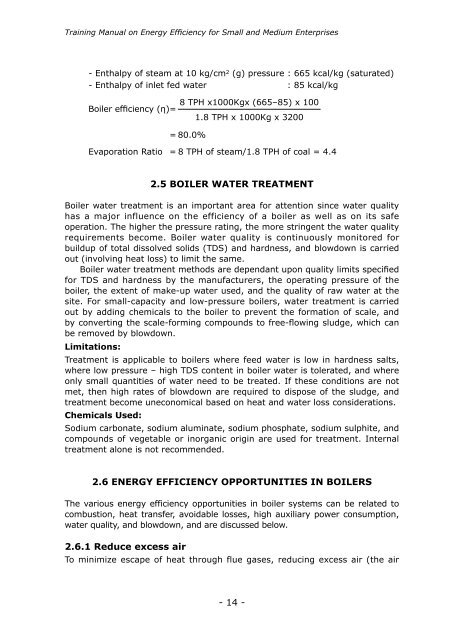Training Manual on Energy Efficiency - APO Asian Productivity ...
Training Manual on Energy Efficiency - APO Asian Productivity ...
Training Manual on Energy Efficiency - APO Asian Productivity ...
Create successful ePaper yourself
Turn your PDF publications into a flip-book with our unique Google optimized e-Paper software.
<str<strong>on</strong>g>Training</str<strong>on</strong>g> <str<strong>on</strong>g>Manual</str<strong>on</strong>g> <strong>on</strong> <strong>Energy</strong> <strong>Efficiency</strong> for Small and Medium Enterprises<br />
- Enthalpy of steam at 10 kg/cm 2 (g) pressure : 665 kcal/kg (saturated)<br />
- Enthalpy of inlet fed water : 85 kcal/kg<br />
8 TPH x1000Kgx (665–85) x 100<br />
Boiler efficiency (η)=<br />
1.8 TPH x 1000Kg x 3200<br />
= 80.0%<br />
Evaporati<strong>on</strong> Ratio = 8 TPH of steam/1.8 TPH of coal = 4.4<br />
2.5 BOILER WATER TREATMENT<br />
Boiler water treatment is an important area for attenti<strong>on</strong> since water quality<br />
has a major influence <strong>on</strong> the efficiency of a boiler as well as <strong>on</strong> its safe<br />
operati<strong>on</strong>. The higher the pressure rating, the more stringent the water quality<br />
requirements become. Boiler water quality is c<strong>on</strong>tinuously m<strong>on</strong>itored for<br />
buildup of total dissolved solids (TDS) and hardness, and blowdown is carried<br />
out (involving heat loss) to limit the same.<br />
Boiler water treatment methods are dependant up<strong>on</strong> quality limits specified<br />
for TDS and hardness by the manufacturers, the operating pressure of the<br />
boiler, the extent of make-up water used, and the quality of raw water at the<br />
site. For small-capacity and low-pressure boilers, water treatment is carried<br />
out by adding chemicals to the boiler to prevent the formati<strong>on</strong> of scale, and<br />
by c<strong>on</strong>verting the scale-forming compounds to free-flowing sludge, which can<br />
be removed by blowdown.<br />
Limitati<strong>on</strong>s:<br />
Treatment is applicable to boilers where feed water is low in hardness salts,<br />
where low pressure – high TDS c<strong>on</strong>tent in boiler water is tolerated, and where<br />
<strong>on</strong>ly small quantities of water need to be treated. If these c<strong>on</strong>diti<strong>on</strong>s are not<br />
met, then high rates of blowdown are required to dispose of the sludge, and<br />
treatment become unec<strong>on</strong>omical based <strong>on</strong> heat and water loss c<strong>on</strong>siderati<strong>on</strong>s.<br />
Chemicals Used:<br />
Sodium carb<strong>on</strong>ate, sodium aluminate, sodium phosphate, sodium sulphite, and<br />
compounds of vegetable or inorganic origin are used for treatment. Internal<br />
treatment al<strong>on</strong>e is not recommended.<br />
2.6 ENERGY EFFICIENCY OPPORTUNITIES IN BOILERS<br />
The various energy efficiency opportunities in boiler systems can be related to<br />
combusti<strong>on</strong>, heat transfer, avoidable losses, high auxiliary power c<strong>on</strong>sumpti<strong>on</strong>,<br />
water quality, and blowdown, and are discussed below.<br />
2.6.1 Reduce excess air<br />
To minimize escape of heat through flue gases, reducing excess air (the air<br />
- 14 -
















